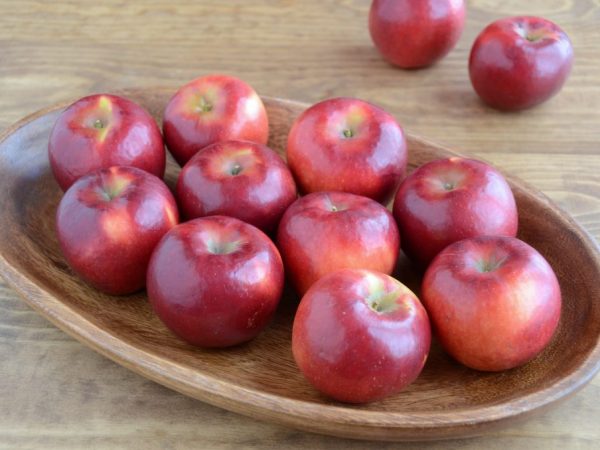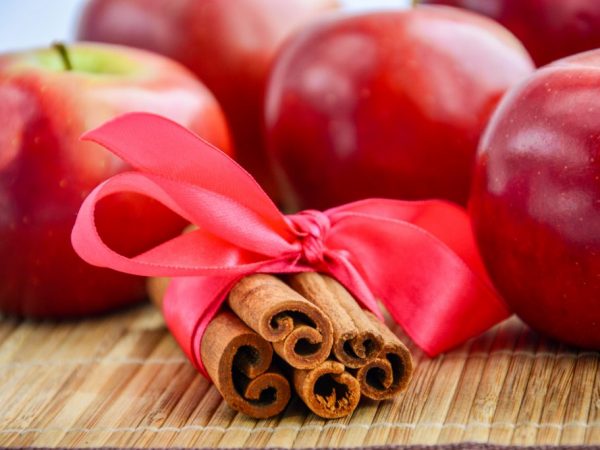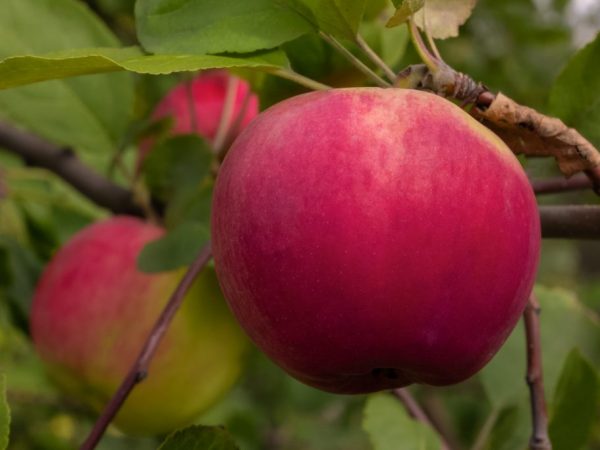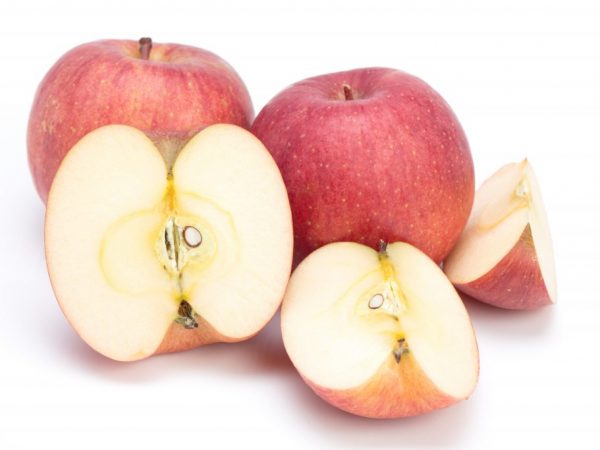Late winter apple-tree Belorusskoe raspberry
Apple-tree Belorusskoe raspberry is a late winter variety with a sour-sweet taste of fruits. It was withdrawn by a group of scientists from a research institute located in the village of Loshitsa near Minsk in 1974.
- Characteristics of the variety
- Taste characteristic
- Yield
- Pollinating varieties
- Winter hardiness
- Disease and pest resistance
- Tree lifespan
- Landing
- Landing dates
- Landing technology
- Care
- Watering
- Top dressing
- Pruning
- Disease and pest control
- Features of ripening and fruiting
- Harvesting and storage
- Subspecies and variants
- Dwarf rootstock
- Columnar rootstock
- What other varieties are suitable for Belarus
- Gardeners reviews
- pros
- Minuses

Late winter apple-tree Belorusskoe raspberry
To get it, we crossed Antonovka with Lovefam. Now it is growing not only in Belarus, but also in the Baltics and Russia.
Characteristics of the variety
The Belarusian raspberry is a medium-sized tree with intensive growth. The crown is not too thick, it is easy to care for it.
The apple tree begins to bear fruit early, so it is often grown on an industrial scale.
Description of the tree and fruit:
- The height of the tree is up to 3-5 m, the crown is round, powerful branches are directed upwards.
- The leaf plate is large, leathery, bends in the center, the end is twisted
- The mass of the apple is 150-200 g, sometimes up to 250 g. The shape is round, the color is light green, a crimson hue appears in the form of barely visible stripes or a continuous blush.
- Seeds are small, few
- The pulp is white, with a light cream shade, rather dense, fine-grained
About 9-10% of the fruit is sugar, about 12% is solids. There are 18 mg of ascorbic acid (per 100 g).
Taste characteristic
Freshly harvested fruits have a pronounced sourness. During storage, they gradually become sweet-sour, spicy. They taste perfect in January and February. The aroma is pronounced, the flesh is crispy and juicy.
Tasters rate the variety at 4-4.2 points out of 5.
Yield
The Belorusskoe Raspberry variety has a good yield: when the apple tree turns 10 years old, 30-40 kg of fruits are removed. From 1 hectare - up to 250-300 centners.
But the yield is unstable. Productivity is very high one year and moderate the next. But there is no lack of fruiting.
It is possible to increase the indicators if fertilizing is applied on time and sanitary pruning is done annually.
Pollinating varieties
The variety is not capable of self-pollination. Its pollen cannot penetrate its own pistils, so the ovaries are practically not formed. This is due to the genetic characteristics of the species.
If there are no other varieties of apple trees nearby, there will be no harvest.
Best suited:
- Antonovka
- Welsey
- Lovefam
- Belarusian sweet
- Minsk
Winter hardiness

The tree is very strong and hardy
The variety was bred specifically for the north. He has high winter hardiness. Shoots do not freeze even at temperatures below -20-30⁰С.
If young twigs with buds are damaged, they quickly regenerate in spring. Such qualities made it possible to grow an apple tree in many regions of Russia.
Disease and pest resistance
The tree is not very resistant to fungus, it is damaged by many insects.The risk of crop loss due to disease is especially great during heavy rains and wet summers.
Trees must be protected from scab, fruit and gray rot, powdery mildew, rust. They are often attacked by moths, suckers, spider mites and aphids.
Tree lifespan
According to the description, due to early fruiting, the tree is quickly depleted. The maximum results are 10 years, and by 20-30 years the yield drops.
Therefore, the lifespan is no more than 30 years. Later it is advised to replace it with new plants. Indeed, at this age, too few fruits are harvested from apple trees, and a normal harvest is obtained every 2-3 years.
Landing
For planting, you need to buy material exclusively from nurseries. It is advisable to do this in your region in order to acquire plants adapted to the respective climate.
Saplings have a specific appearance: they are tall, the trunk is well pubescent, thickened. The color of the bark is brown-cherry. There are few lentils, branches up to 3-4 pieces.
It is advisable to purchase annual seedlings - they should be fresh, only dug out of the ground. To prevent the root system from drying out, it is wrapped in moss or a special film.
Landing dates
The apple tree is planted either in the fall or in the spring. Since the variety is grown in northern regions, spring planting is preferred by many gardeners.
You need to prepare a hole in the fall. The seedlings are transferred to the ground from mid-April to early May. ...
It is necessary to take care of wintering. The pit is prepared in 2-3 weeks. After planting, cover the soil with mulch to prevent the roots from freezing. It is advisable to cover a young seedling for the winter with foil or straw, tie it to a support to protect it from the wind.
Landing technology

Apple trees do not like winds
For the apple-tree Belorusskoe Raspberry, a sunny place protected from the winds is suitable. Does not like the variety of clay and peat soils, high humidity. Groundwater should be located at a depth of more than 1 m.
Trees should be planted at a distance of 4-6 m from each other, as their crown and roots are quite wide. The size of the pit is 80 × 100 cm.
If the soil on the site is fertile, the depth of the pit can be up to 60 cm.
They put in the pit:
- A drainage layer of expanded clay, pebbles or coarse river sand.
- Land mixed with complex fertilizer (you can replace it with a mixture of superphosphate, potassium chloride and wood ash).
- Compost or humus.
Sprinkle everything on top with soil, leave it for 2-3 weeks or all winter (for spring planting).
A peg is driven into the hole. Then the root system is freed and the tree is lowered. They fall asleep with earth so that the root collar is free and rises by 2-3 cm.
Pour 2-3 buckets of water under the seedling. If he is young and thin, tied to a support. Around the trunk, mulch is poured from sawdust, peat, rotten manure, compost, or this space is lined with agricultural film.
Care
It's easy to take care of: the apple tree needs regular watering at a young age and regular fertilization.
The crown is advised to prune to prevent diseases and increase yields. It is also important to engage in pest prevention and control.
Watering
Water the tree 2 times a month if the weather is dry and hot. The rest of the time, once for 30 days is enough. Use 3-4 buckets of water.
Be sure to irrigate after fertilizing.
Top dressing
Fertilizers are applied 2-3 times per season: when buds appear, during the formation of ovaries, sometimes after ripening and picking apples.
Organic matter is applied in the spring. Two grooves are pulled out near the trunk, one at a distance of a meter, the other on the opposite side at a distance of 50 cm. Fertilizer is poured into them, then the apple tree is watered.
As a top dressing, bird droppings or slurry from manure are used.
The litter is diluted in a ratio of 1:30 with water and insisted for 10 days. The manure is diluted 1:10, insisted for 5-6 days.
In the autumn and when the ovaries begin to grow, the tree needs minerals. The foliage is sprayed with urea (1 tablespoon per bucket).
On the eve of flowering, together with organic fertilizers, add:
- Superphosphate - 150 g
- Potassium chloride - 55 g
In the fall, use the following mixture:
- Superphosphate - 90 g
- Urea - 35 g
- Potassium chloride - 35 g
Wood ash, which is rich in nitrogen and potassium, can be easily used as a mineral supplement. If the soil on the site is acidic, liming is carried out.
Pruning
During the first years of life, the tree needs regular pruning in order to form a crown. Twigs growing up are shortened. This stimulates the growth in width.
Shoots that grow parallel to the stem are also removed. Formative pruning is done in the fall, after the leaves fall. At the beginning of spring, sanitary cleaning is needed. At the same time, broken, damaged and diseased branches are removed.
Disease and pest control
In order for the garden to be reliably protected from pests and prevent diseases, you need to plant trees correctly. The gaps are made at least 4-5 m.
It is also necessary to thin out the crown in time.
In the first spring months, they are treated with fungicides (Fitosporin, Topaz). The harmless biological products Zircon, Healthy Garden, and Amulet have proven themselves well.
From pests they use Karbofos, Ekoberin and the same Zircon. It is useful to plant wormwood, tansy, marigolds, dill, onions under an apple tree. These plants scare away insects with their smell.
In the summer, foliage is constantly examined. If there are few pests, you can get rid of them with folk remedies - infusion of tobacco, garlic, ordinary laundry soap.
In the fall, the fallen leaves are collected and the site is dug up. You can add insecticides and fungicides to the soil to destroy fungi and larvae. All damaged branches and leaves are removed before wintering. To protect the roots, mulch is lined near the trunk.
Features of ripening and fruiting

The apple tree quickly begins to bear fruit
The variety Belorusskoe Raspberry is distinguished by early fruiting: apples can be harvested after 3-4 years.
If you graft a stalk on a dwarf rootstock, you can get the harvest as early as 2-3 years.
The yield of the variety is unstable. Plentiful fruiting periods alternate with moderate ones.
The maximum amount of the crop is 40 kg. With a decrease - 15-20 kg. From 1 hectare get 200-300 centners.
Fruit formation occurs on ringlets and young fruit twigs. Ripening begins in the last decade of September.
Green apples gradually take on a raspberry blush. The fruits that grow inside the crown have limited access to the sun, therefore they often remain yellow-green, with small red patches.
Harvesting and storage
Harvesting begins at the end of September, when they are fully ripe. Fruits rarely fall, but it is not worth delaying the collection. Indeed, in wet weather, they often begin to rot.
They pick apples with their hands, along with the stalks. The wax coating cannot be washed off, it provides long-term storage.
After harvesting, the fruits are placed in boxes, restoring them with dry grass, straw, special shavings or paper. After that, the boxes are immediately sent to storage.
Best of all, they retain their qualities at a temperature of 1-5⁰С. This can be done in a refrigerator or basement.
Keeping quality is good. Products are stored until early May next year. The taste only improves during storage. The apple becomes sweeter and more aromatic, the pulp acquires a buttery texture.
Partially the fruits are sent for processing. Juices are crushed from them, jams and marmalades are cooked, compotes are made. But most gardeners prefer to consume apples fresh. At the end of winter and in spring, they can be profitably realized. Indeed, at this time, prices for fruits are very high.
Subspecies and variants
There are rootstocks for cultivation.
The standard apple tree is quite large, has a height of 4-5 m. It is prone to some thickening of the crown, requires constant pruning.
Dwarf rootstock
The trees are small - up to 3 m.
The crown is not too thick, pruning can only be carried out for a few seasons.In terms of winter hardiness and productivity, this option is in no way inferior to the standard one.
Gardeners who grow apples for sale prefer their dwarf subspecies.
Columnar rootstock
The branches grow almost parallel to the trunk, they form near the ground.
The height of the tree is no more than 2 m (most often 1.1-1.5 m). Apple trees do not take up much space in the garden, they bear abundant fruit.
What other varieties are suitable for Belarus
Apple trees in Belarus can be found in almost all gardens. Winter-hardy varieties are best suited for growing in this region.
It is desirable that the period of their flowering falls on the second half of May. At this time, the risk of frost is minimal, which means that the crop will not die due to freezing of flowers and ovaries.
The following varieties meet the listed requirements:
- Minsk. Launched at the same station as Belorusskoe Raspberry, but 50 years earlier. The Welsey variety became the basis, but the hybrid exceeds it in winter hardiness. Refers to late winter varieties.
- Belarusian sweet. It is also a product of local selection. In terms of properties and appearance, it is very similar to raspberry, only its fruits are much sweeter.
- Belarusian synap. A hybrid of Antonovka and the Lithuanian variety Pepin. Differs in frost resistance and insensitivity to scab, partially self-pollinates. The taste is sour-sweet, apples can be safely sent for winter storage, they are eaten until early June.
- Banana. Obtained by crossing the Babushkino variety and the American Banana hybrid. It is considered one of the most suitable for winter storage, retains its qualities until June. The taste is harmonious, the flesh is juicy, the color of the peel is straw-yellow.
- Seruel. The result of crossing the cultivars Welsey and Serinka. Fruits ripen at the end of September, are stored for more than six months. It is a good pollinator.
In addition to the actual Belarusian varieties, others are grown in the country: Idared, Antonovka, Malinovka, Elena, Luchezarnoe, Champion, Spartan, Geneva, American Honey Crisp, Navavita, Antey.
Gardeners reviews
pros
The apple variety Belarusian raspberry has the following advantages:
- The variety is winter, characterized by frost resistance and unpretentiousness.
- Early maturity: after 2-3 years, you can get the first delicious apples. The yield increases steadily in the first 10 years.
- You can store apples until mid-May. The taste improves during storage, while the juiciness and firm structure of the pulp are preserved.
- The trees are compact and take up very little space in the garden. First of all, this applies to dwarf and columnar rootstocks.
Minuses
There are also some negative reviews about the variety.
- Weak resistance to diseases and pests. Therefore, trees need constant processing and protection.
- The tree needs pruning pruning, otherwise the crown will become too thick.
- Productivity is not very stable, especially in mature and old trees. Therefore, the garden needs to be constantly renewed.

